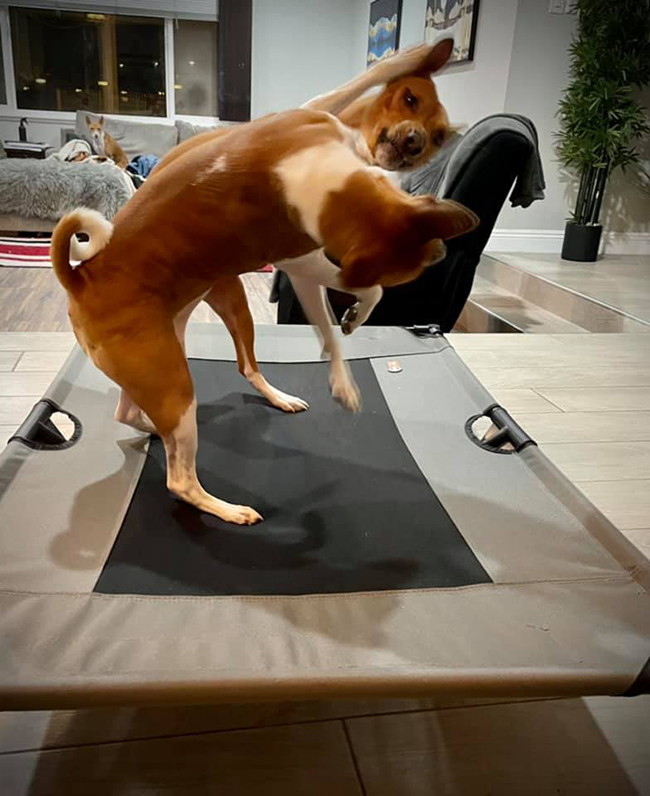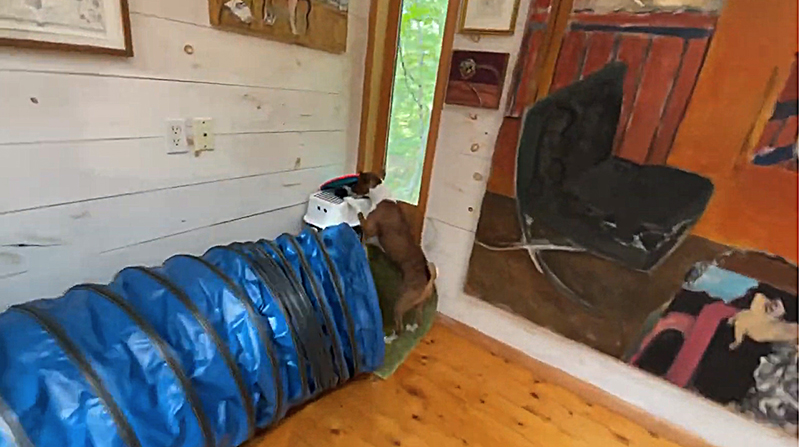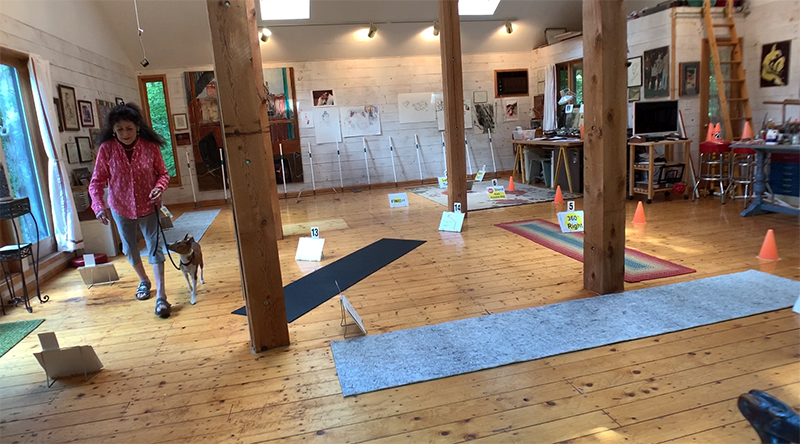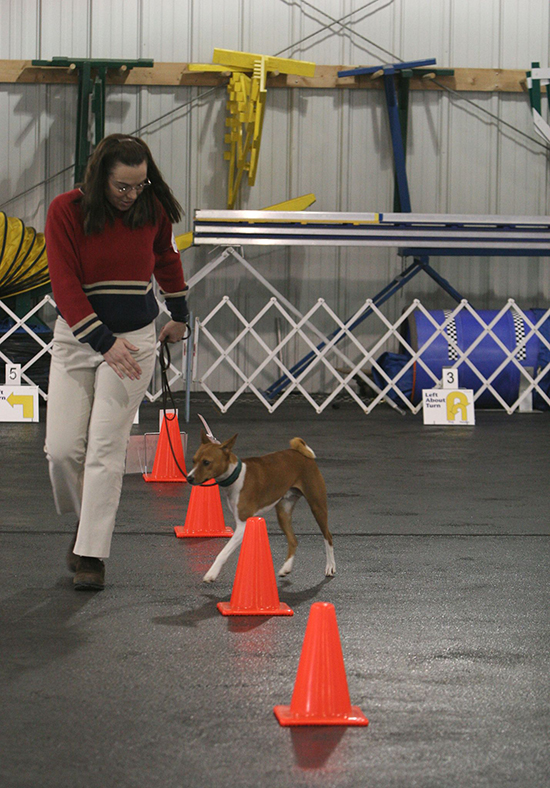The Rip Van Wrinkler, XXV, Issue 4, November 2021
Page 7 <previous page> <next page>
Training Conversation 50!
Ashley Lorin photo above - Dog gymnastics event 1. Trampoline team. Note the judge, older and wiser, in the referee box.
1. Noreen on sportsmanship.
2. AKC makes virtual Rally program permanent.
3. AKC Virtual Scentwork.
Noreen Bennett!
During each agility weekend, I hear the same thing: "I don't understand why my dog doesn't do the (fill in the blank). He does it at home.I can do it 20 feet away. It only happens at shows." The answer is "Because it's different at shows." No one ever explains what that means.
It's like your parents saying because I said so. Why is it different at shows? Here's my take.
Part 1- Successful agility training also means changing variables. As much as we increase distractions around equipment, in preparation for our first time in the ring, there is one HUGE variable that the majority of us have not practiced and that is the size of the arena. Many novice exhibitors train in a much smaller arena than a regulation size ring and as a result often work only 7-10 obstacles. The first time the dog competes, we change a HUGE variable . They go from training in a 50x50 arena to 100x100. And then we dont'/can't train in the ring -we go in with no food, no toys and not touching our dogs to praise them. Most of us cant even remember to praise verbally since we're trying to remember the course and not get lost.
Does changing a variable REALLY make a difference ? Yes yes yes. When I am teaching a new trick, such as crossing paws, I sit on the floor. Once the dog gets it, i may sit in a chair. The change of that one variable is enough to have to start teaching the trick from scratch. Standing up instead of sitting -we start again. Moving 10 feet back, moving 20 feet back, we start from scratch AGAIN. With each variable we progress more quickly.
Part 2- The atmosphere, energy, pheremones, whatever you want to call it -is different at a show. You can't fake indifference. You can't control .how other dogs react or emit signals. Not buying it? Think that you are calm and in control? Did you watch your dog and see the ears pinned back? Your dog won't tug or play. Dogs can sense when a human is going to have a seizure, they can sniff out drugs, they know you are awake even though you haven't opened your eyes because your breathing has changed. So yes, yes, yes -the energy at a show is another variable that your dog is now dealing with.
I don't have a fail safe method to deal with all of the above. i struggle with it as much as everyone else because each dog needs something different. you can train a system but in the end you have to train YOUR dog, not a system. So this small novel is for my novice exhibitors that don't understand why things are different at a show. it is different to the dog -drastically different for most dogs so give yourself a break and give the dog some room to acclimate and adjust to this new variable. Your dog will come around quicker if you adjust your expectations for your first show and realize your dog is adjusting all over again to some big changes and may not be able to give you the same focus you had at home or class. It's okay -and it's normal..
Nina AB Daniel
Dogs are terrible generalizers.
If we can change a tire in our driveway on a particular car we could probably change that same tire at a rest stop or in Tulsa.
A dogs brain does not work that way. When you change the environment it becomes a brand new thing. We need to spend time helping them be at ease in tons of different environments.
AKC Virtual Scentwork Test.
GUIDELINES
Section 1. Purpose of the Virtual Scent Work Test. The purpose of the AKC Virtual Scent Work Test (VSWT) is to offer both dogs and owners a way to engage in an activity which utilizes a dog’s natural ability to detect search items through self-reward and from the comfort of a home environment. This test will serve as an introduction and preparatory stage for a dog/handler team wishing to get started in detection work. They are able to work incrementally at their own pace, developing skills and confidence. When a team is ready, they can demonstrate basic competency in locating an item based on scent by taking this pass/fail test. The test must be recorded on video and submitted to the AKC to be reviewed by a judge. This is a great way to get started in Scent Work, maintain skills from your home or allow dogs bonding time with their owners which can help prevent boredom.

Section 2. Eligibility. The Virtual Scent Work Test welcomes any dog which is at least four months of age and is individually registered with the AKC, recorded in the Foundation Stock Service (FSS) program, is listed with a Purebred Alternative Listing (PAL) number, or enrolled in the AKC Canine Partners program. Owners needing to learn more can visit https://www.akc.org/register/dog/ for more information and how to obtain eligibility.
Section 3. Testing Format. The Virtual Scent Work Test consists of three levels – Beginner, Intermediate and Experienced. Each level calls for specific types of search items be searched within a certain number of search areas utilizing different search environments. An environment can be different rooms or parts of the home’s exterior. The search area is defined as a specific type of area within the search environment. A search area can be a garage, living room, kitchen, dining room or exterior space on the grounds of the home such as a front yard, back yard, driveway, detached dwelling, patio, deck or porch area. For the Experienced level only, an environment is defined as a combination of the interior and exterior of the home.
Each test level has its own set of testing criteria. Only one search item per search area is allowed for any test level. (refer to the Testing Criteria table.) For the Beginner level, the dog must find one search item, a choice of ball or toy or treat inside the home at floor level within one and a half minutes in one search area. At the Intermediate level, the dog must find two different items out of the following items – ball, toy, treat, on the grounds of the home’s exterior at a height range of one to two feet in two and a half minutes across two different exterior search areas. At the Experienced level, the dog must find all three items - ball, toy, and treat within three minutes and across a combination of three search areas using interior and exterior environments and a height between two and three feet.
Section 4. Search Items. The search items used for the VSWT can be one, some or all of the following items depending on test level – ball, toy, treat. An example of a ball can be a tennis ball or a rubber ball. The ball should be similar in size to a tennis ball. An example of a 2 toy can be that of a rope tug toy, a soft fabric toy, or a rubber squeaky toy or similar. All toys used should be relatively the same in size and should not exceed an approximate dimension of 6” wide x 4” long x 2” thick. An example of a treat would be a small piece of hotdog or a small milk bone. The treat used should not exceed an approximate size of 1” x ½”. It is recommended the search item used be a size and shape that can be easily hidden around the home environment.
Section 5. Virtual Scent Work Title Structure. The Virtual Scent Work Test - Pilot Program offers three suffix titles. To earn a Virtual Scent Work Beginner (VSWB) title a dog must pass two different Beginner level tests on two separate occasions. To earn a Virtual Scent Work Intermediate (VSWI) title a dog must pass two different Intermediate level tests on two separate occasions. To earn a Virtual Scent Work Experienced (VSWE) title a dog must pass two different Experienced level tests on two different occasions. Higher titles supersede lower titles and titles must be earned in the order of difficulty starting with Beginner.
Section 6. Conducting a Virtual Scent Work Test.
A. The Blind - To maintain the integrity of the search, it is required that during the placement of any search item, the dog must not be in the search area. The dog must be in another room or partitioned so there is clear separation and cannot see the placement of any item. For the purposes of this test, we will refer to the location where the dog is separated out of view, as the blind. While the dog is in the blind, there cannot be any visibility to the placement of a search item. Once all items have been placed, the dog can be released into the search area.
B. Timing - No hand timer will be used, the time shown in the video will serve as the official timing device. The countdown clock begins upon the dog’s entrance to a search area and continues until the item is found. The collective time used to search for item(s) presented in a test, must not exceed the maximum search time allotted per test level.
C. Separation of Search Areas - A search area is an area within a search environment which is identified by a boundary or specific point of demarcation. If more than one search area is used and the separation between search areas are not well defined, the handler must verbally on camera show the judge during test setup, the point of reference which divides the two areas. The handler while describing the separation can reference an object as a point of separation from one search area to the next. Two search areas could be separated by significant objects or structures such as cones, ring gates, half walls, or fencing. Example: A large yard may have a row of shrubs which could be used to separate two areas of the yard. 3
D. Movement Through Search Areas – If after a dog successfully finds the first search item, additional search items remain, the dog may be directed towards the next search area or continue unassisted. Directing can be done verbally or in the form of walking the dog to the search area. The dog must be unassisted once the search area has been entered. A dog does not have to complete one search before moving to the next search area. A dog may work by searching out the items between the two search areas. Interior searches of the home should be off leash. If a search is conducted on the exterior grounds of the home, the handler has the option to work on leash. While searching on leash, the dog should be able to move freely and not be pulled or guided in the direction of the search item. Whatever way a test is configured, it must be clear to the judge when a new search area has been entered.
E. Dog/Handler Team Communication - During the search, the dog can receive encouragement but may not be led to the exact location of the hidden item. If the judge determines the dog is being assisted in locating the search item, the video will be returned. All decisions by the judge are final. If the dog mistakenly leaves a search area, the handler may verbally encourage the dog to re-enter the search area to continue to search. Praise and reward can be given once a search item is located. The VSWT program is meant to be a self-rewarding exercise, meaning that when the dog finds the item, keeping the item is the dog’s reward. It must be evident to the judge when the dog has found the item. After the search, additional rewards and praise can always be offered.
F. Placement of Search Items - Each of the three test levels have their own testing criteria. When conducting a test, the correct type of search environment, area, and item must be used under the correct level as well as within the correct height range for placement of the item. Search items must not be placed near the entrance of the search area. The handler must make every effort to place the item furthest the entrance of a search area. It is important tests are setup to show the judge a reasonably challenging test was conducted. Handlers must utilize the surrounding of the home in a way that offers a quality test while understanding the VSWT is intended to show basic detection. It is important items are placed in a way that conceals them from view. Using cover such as leaves, pillows, or magazines can help prevent exposure. Examples would be placing a ball in a flowerpot covered by leaves, placing a toy on a chair behind pillows, placing a treat in a basket underneath a pile of magazines. When placing an item, the relationship and proximity of one search area to the next must also be considered and indicated verbally in the video for the judge. The dog must show a working effort in searching out the item in order to pass. Upon the dog finding the item, it must be clear the item found was the same item placed. Once the final search item is found the test is concluded and the dog may keep the item or bring it to the owner. No distractions are used for a Virtual Scent Work Test.
G. Collars/Leashes - Special Training devices that are used to control and train dogs, including but not limited to, collars with prongs, electronic collars used with transmitters, muzzles and head collars may not be used on dogs entered in a VSWT.
For Questions about the VSWT call: 919-816-3844 or email: scentwork@akc.org
-----------------------------------------------------------------------------------------------------------------------------------------------
AKC Rally® Virtual Program.

The AKC Rally Virtual program is open to all dogs six months of age and older. Dogs entered in the Rally Advanced class must have earned the Rally Novice (RN) title and may have earned the Rally Intermediate (RI) title according to the owner’s records. Qualifying in the Rally Advanced class three times will result in the dog earning the Rally Advanced (RA) title.
Dogs entered in the Rally Excellent class must have earned the Rally Advanced (RA) title according to the owner’s records. Qualifying in the Rally Excellent class three times will result in the dog earning the Rally Excellent (RE) title. All qualifying scores will be recorded on the dog’s AKC record and applied toward the three required for the Rally Advanced and Rally Excellent titles.
The qualifying scores and titles earned virtually are the same as those earned at in-person events. You may earn a title by qualifying at either or both types of events. The RAE class is not offered in this virtual program and therefore, virtual classes cannot be used to earn the RAE title where double Qs at the same event are required. Rally Championship (RACH) points will be recorded for dogs after they have earned the Rally Excellent (RE) title, for scores of 91 or better in the Rally Advanced and Rally Excellent classes in the virtual program.
The scores earned virtually will not be eligible to use to qualify for entry into the AKC Rally National Championship events.
There are five pre-designed courses published on the AKC website for the exhibitor to choose from. The exhibitor will setup the course according to the Instructions provided in the Virtual Rally Guidebook. They will video the performance, upload the video to their personal YouTube account, set the required YouTube viewing options, and submit the video link with the online entry form and pay the fee electronically to AKC.
WE ARE EXCITED TO OFFER THIS VIRTUAL OPTION TO OUR RALLY EXHIBITORS PERMANENTLY!
For more information go to https://www.akc.org/sports/rally/rally-virtual-entry/
 2005, Kunjo - Mary Bloom photo.
2005, Kunjo - Mary Bloom photo.